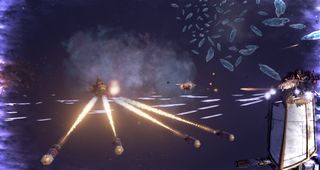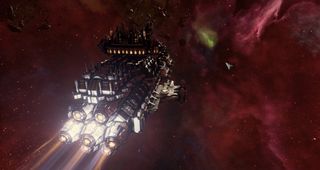Our Verdict
A tubthumping tribute to the 40K universe, with perfectly grim design. Multiplayer definitely needs work on its balance though.
PC Gamer's got your back
‘Save-scumming’ is such an over-weighted phrase. It’s just loading the game when you lose a battle, not punching babies. And, amongst our modern virtues a steel-jawed refusal to give in, no matter the odds, is called bravery, and not foolhardiness or fantasy. So, yes, I save-scummed Battlefleet Gothic. But when I stopped—when I gave in—the developers showed me that they’d made a better game for those who were prepared to lose.
What is it Galleon-style spaceship combat in the Warhammer 40,000 universe.
Publisher Focus Home Interactive
Developer Tindalos Interactive
Reviewed on Intel i7 860, 8GB RAM, GTX 970.
Expect to pay £27
Multiplayer 1v1, 2v2.
Link Official site
Battlefleet Gothic: Armada is hard. It's one of the first RTSes for an age that’s actually tactically trying. You take command of a fleet of mile-long human spaceships that are patrolling a huge sector of space in the Warhammer 40K universe. Eldar Pirates, Ork Freebooters and and a massive Chaos fleet are lurking in the nebulae, waiting for you to stumble.
In the long single player campaign, you have a limited number of mission deployments a turn. A light-touch tutorial takes you through the start of the campaign and is still going several hours in, as the plot really kicks off. This turns into a nicely branching narrative that introduces all the enemy factions, tracks how you’ve done in earlier missions and punishes early failures later on—hard.

In the skirmish and multiplayer modes, you just go straight into the missions. This keeps the campaign’s RPG elements, but disposes of the map, just letting you face off against other players' fleets. The beta definitely has raised lots of issues with balance, but the servers seem reliable at the time of writing.
Before each mission, you’re given a briefing and a set amount of resources to spend on ships, which typically allow you to take a handful of your upgradeable big ships along with you, as well as a few disposable escorts. In some you’re targeting the enemy flagship, while in others you have to destroy transports or just have the last working ship.
Then you deploy your ships on a battle map. Having just come from playing Fractured Space, seeing battles on a 2D plane was a little disappointing. But I didn’t notice after ten minutes in, because I was too busy micromanaging my ships. Every ship, even the lowliest escort, has a range of abilities, and every faction has a good range of ships, which unlock more and more abilities as they’re used. Thankfully, many of the abilities can be set to auto-activate, which the game does intelligently, and there’s a slowdown mode which gives you time to dodge bombs and execute handbrake turns.

Some of the mission types are inherently more winnable than others, and you have to start gaming the game to defeat them. For example, one of the critical plot missions requires one of your ships of the line to travel to three points on a highly contested map. But the time limits to get to these points are extremely tight—impossibly tight if you don’t have spare resources or if the enemy drops a Stasis Bomb in your way. Even having rejigged my light cruiser loadouts so that they could boost for twice as long, it took me four more goes to win it.
Similarly, any mission where you must defend transport ships is normally a write-off. Assassination missions can also be hard. And any mission against the agile Eldar corsair fleet can be frustrating given their greater speed and mobility—pinning an enemy flagship in the map’s corner to kill them doesn’t feel very glorious.
On normal campaign difficulty, you’ll probably lose half your battles. Losing means the game also gets harder in the short run, because you get fewer resources for a defeat, but there are ways of avoiding that. For your ships of the line—the big ships—you can warp them out whenever you want and they’ll also try to flee themselves sometimes.

Lose a ship in battle and it takes a couple of turns to rebuild or repair. As your Admiral levels up, he unlocks more ship slots and better ships. Ships themselves level up too, which means that your early ships are still useful even late in the campaign. And even though the smaller frigates never level up, they’re always useful to fill in a shortfall in your cost.
Battlefleet Gothic gets so much right. The campaign’s story, script, voice acting and appearance is all spot-on for the 40K universe. The 2D battles are challenging and interesting, if still quite unbalanced. The RPG elements are horribly compelling. And its detailed, nebula-filled universe brings the tiny tabletop models to life—before they’re blown into thousands of pieces.
A tubthumping tribute to the 40K universe, with perfectly grim design. Multiplayer definitely needs work on its balance though.

After 6 years, the FCC has voted to restore net neutrality regulations in a win for the open internet

Hasbro says Magic: The Gathering's Fallout-themed Commander cards were 'probably our best-performing Commander set ever'

After 10 years on Steam, Korean MMO ArcheAge is giving up on North America and Europe
